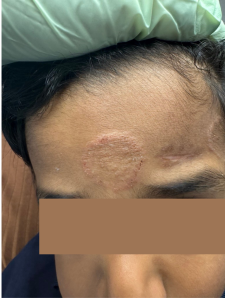

Parents often worry when they spot a mysterious rash on their child’s face. In this week’s Derm Diaries, we’re highlighting a common yet often misdiagnosed skin infection we see in pediatric dermatology — tinea faciei, also known as ringworm of the face.
Our young patient, a playful toddler, was brought into our clinic after his parents noticed three distinct, red, expanding rings on his cheeks and chin. The rash appeared over the course of a week, growing in size and developing a scaly edge. Initially mistaken for eczema or a reaction to food, the telltale ring-like shape and spread pattern gave us important clues.
Despite its name, ringworm isn’t caused by a worm at all. It’s a contagious fungal infection caused by dermatophytes that affect the skin’s outermost layer. When it appears on the face, it’s referred to as tinea faciei — a condition more common in children due to their close contact with pets, shared towels, and playground surfaces.
• Circular, red patches with raised, scaly edges
• Central clearing that makes the rash appear ring-shaped
• Itchiness or mild discomfort
• Often worsens with steroid creams, which can delay diagnosis
In this case, a KOH (potassium hydroxide) test confirmed the diagnosis. We initiated treatment with a pediatric-friendly topical antifungal cream and provided strict guidance to avoid steroid use, which can mask the infection and cause it to spread further.
For more extensive or stubborn cases, we also consider oral antifungal medications, especially when the infection is near the eyes or involves hair-bearing areas where creams may not penetrate effectively.
• Avoid sharing towels, hats, and pillowcases
• Wash hands frequently, especially after petting animals
• Keep skin clean and dry
• Seek medical attention promptly if a rash spreads or worsens
Children’s skin isn’t just “mini adult” skin — it’s more sensitive, and conditions can look very different. That’s why our board-certified dermatologists at Dermatology Solutions offer expert pediatric dermatology care tailored for our youngest patients.
If you notice any persistent or worsening rash that doesn’t respond to over-the-counter creams — especially if it forms a ring — don’t hesitate to reach out. Early treatment of ringworm prevents spread, scarring, and discomfort.
Check out the patient photo above to see how classic ringworm of the face can present in children — and how timely diagnosis leads to quick resolution
Disclaimer: The photos shown are actual images of our patient, shared with explicit written consent. These images are for educational use only and may not be copied, distributed, or reproduced without permission from our office.